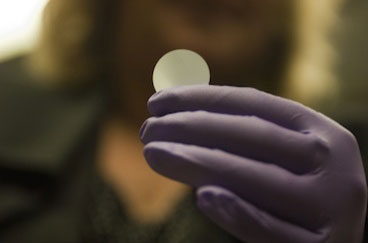Scientists are reporting the development of a new, ultra-light form of 'frozen smoke' - renowned as the world's lightest solid material - with amazing strength and an incredibly large surface area.
Jan 13th, 2011
Read more
Researchers at the University of Calgary, in Canada, collaborating with the University of Paderborn, in Germany, are working on a way to make quantum networks a reality.
Jan 12th, 2011
Read more
Using a highly sophisticated atomic-scale imaging tool on a sea creature's tooth, two Northwestern University researchers have peeled away some of the mystery of organic/inorganic interfaces that are at the heart of tooth and bone structure.
Jan 12th, 2011
Read more
Two tiny molecular layers in a liquid that traps carbon dioxide constantly swap places, influencing how much of the greenhouse gas is absorbed, according to scientists.
Jan 12th, 2011
Read more
This conference is organized with the intention of again providing a forum for continued discussion on the latest developments in two of the most critical high-tech fields, i.e., Ultra Large Scale Integrated Circuits (ULSIC) and Thin Film Transistor (TFT). It is aimed at the exchange of state-of-the-art information among those involved in research, development, and production of semiconductor materials, processes, and devices.
Jan 12th, 2011
Read more
Scientists at Helmholtz-Zentrum Berlin fuer Materialien und Energie (HZB) and the Technische Universitaet Berlin (TUB) now present a method that takes us a good step towards producing a "molecular movie". They can record two pictures at such a short time interval that it will soon be possible to observe molecules and nanostructures in real time.
Jan 12th, 2011
Read more
The physical length of an ordinary laser cannot be less than one half of the wavelength of its light, which limits its application in many industries. Now the Spaser, a new invention developed in part by Tel Aviv University, can be as small as needed to fuel nanotechnologies of the future.
Jan 12th, 2011
Read more
Fifty-one years after Richard Feynman envisioned nanoscience in his famous address, 'Plenty of Room at the Bottom', four extraordinary researchers joined in a roundtable discussion of the future of nanoscience.
Jan 12th, 2011
Read more
 Separating molecules is an important part of many manufacturing and testing processes, including pharmaceutical production and some biomedical tests. One way of carrying out such separation is by using nanofilters - materials with holes of a precisely controlled tiny diameter, to allow molecules up to that size to pass through while blocking any that are larger. But a new system devised by researchers at MIT could add an important new capability: a way to selectively filter out molecules of the same size that have different chemical properties.
Separating molecules is an important part of many manufacturing and testing processes, including pharmaceutical production and some biomedical tests. One way of carrying out such separation is by using nanofilters - materials with holes of a precisely controlled tiny diameter, to allow molecules up to that size to pass through while blocking any that are larger. But a new system devised by researchers at MIT could add an important new capability: a way to selectively filter out molecules of the same size that have different chemical properties.
Jan 12th, 2011
Read more
Frank Burnett, Emeritus Professor of Science Communication at the University of the West of England, has written a concise 26 page Guide designed to help scientists, engineers and technologists develop effective, attention-grabbing ways of communicating what they do and why they do it to public audiences.
Jan 12th, 2011
Read more
A novel concept of organic photovoltaic cell based on the optical absorption due to charge-transfer between different organic molecules was developed by Japanese researchers.
Jan 12th, 2011
Read more
Nanotechnologien und Neue Materialien sind Innovationstreiber fuer die Entwicklung intelligenter und multifunktionaler Verpackungen. Das Anwendungsspektrum reicht von verbesserter Barriere- und Schutzfunktion ueber neuartige Sicherheitsmerkmale fuer den Faelschungsschutz bis hin zu Smart Labels fuer intelligente Verpackungen der Zukunft.
Jan 12th, 2011
Read more
Rice, BCM discovery addresses key roadblock to growing replacement tissues, organs.
Jan 12th, 2011
Read more
 Nanoparticles play a significant role in the development of future diagnostic and therapeutic techniques for tumors, for example as transporters for drugs or as contrast agents. Absorption and dispersion of nanoparticles in tumor tissue depend strongly on particle size. In order to systematically study this, scientists at the Massachusetts Institute of Technology and Harvard Medical School have now produced a set of fluorescent nanoparticles of various diameters between 10 and 150 nm.
Nanoparticles play a significant role in the development of future diagnostic and therapeutic techniques for tumors, for example as transporters for drugs or as contrast agents. Absorption and dispersion of nanoparticles in tumor tissue depend strongly on particle size. In order to systematically study this, scientists at the Massachusetts Institute of Technology and Harvard Medical School have now produced a set of fluorescent nanoparticles of various diameters between 10 and 150 nm.
Jan 12th, 2011
Read more
In a timely review paper, scientists from Japan, Germany, and Spain provide a highly relevant overview of the history, physical interpretation and applications of plasmons in metallic nanostructures.
Jan 12th, 2011
Read more
A simple technique to make a common virus-killing material significantly more effective is a breakthrough from the Rice University labs of Andrew Barron and Qilin Li. Rather than trying to turn the process into profit, the researchers have put it into the public domain.
Jan 12th, 2011
Read more



 Subscribe to our Nanotechnology News feed
Subscribe to our Nanotechnology News feed